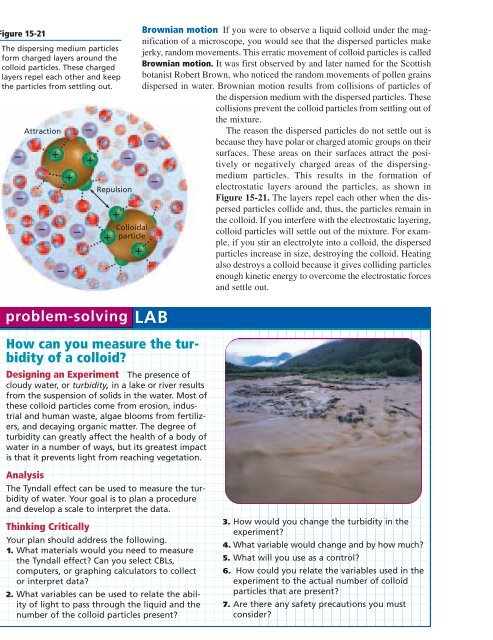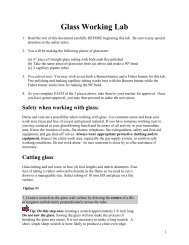Chapter 15: Solutions - Weironline.net
Chapter 15: Solutions - Weironline.net
Chapter 15: Solutions - Weironline.net
You also want an ePaper? Increase the reach of your titles
YUMPU automatically turns print PDFs into web optimized ePapers that Google loves.
Figure <strong>15</strong>-21<br />
The dispersing medium particles<br />
form charged layers around the<br />
colloid particles. These charged<br />
layers repel each other and keep<br />
the particles from settling out.<br />
�<br />
�<br />
Attraction<br />
�<br />
�<br />
� �<br />
�<br />
�<br />
�<br />
problem-solving LAB<br />
How can you measure the turbidity<br />
of a colloid?<br />
�<br />
Designing an Experiment The presence of<br />
cloudy water, or turbidity, in a lake or river results<br />
from the suspension of solids in the water. Most of<br />
these colloid particles come from erosion, industrial<br />
and human waste, algae blooms from fertilizers,<br />
and decaying organic matter. The degree of<br />
turbidity can greatly affect the health of a body of<br />
water in a number of ways, but its greatest impact<br />
is that it prevents light from reaching vegetation.<br />
Analysis<br />
The Tyndall effect can be used to measure the turbidity<br />
of water. Your goal is to plan a procedure<br />
and develop a scale to interpret the data.<br />
Thinking Critically<br />
Your plan should address the following.<br />
1. What materials would you need to measure<br />
the Tyndall effect? Can you select CBLs,<br />
computers, or graphing calculators to collect<br />
or interpret data?<br />
2. What variables can be used to relate the ability<br />
of light to pass through the liquid and the<br />
number of the colloid particles present?<br />
�<br />
478 <strong>Chapter</strong> <strong>15</strong> <strong>Solutions</strong><br />
�<br />
Repulsion<br />
Colloidal<br />
particle<br />
�<br />
Brownian motion If you were to observe a liquid colloid under the magnification<br />
of a microscope, you would see that the dispersed particles make<br />
jerky, random movements. This erratic movement of colloid particles is called<br />
Brownian motion. It was first observed by and later named for the Scottish<br />
botanist Robert Brown, who noticed the random movements of pollen grains<br />
dispersed in water. Brownian motion results from collisions of particles of<br />
the dispersion medium with the dispersed particles. These<br />
collisions prevent the colloid particles from settling out of<br />
the mixture.<br />
�<br />
�<br />
The reason the dispersed particles do not settle out is<br />
because they have polar or charged atomic groups on their<br />
surfaces. These areas on their surfaces attract the positively<br />
or negatively charged areas of the dispersingmedium<br />
particles. This results in the formation of<br />
electrostatic layers around the particles, as shown in<br />
Figure <strong>15</strong>-21. The layers repel each other when the dispersed<br />
particles collide and, thus, the particles remain in<br />
the colloid. If you interfere with the electrostatic layering,<br />
colloid particles will settle out of the mixture. For example,<br />
if you stir an electrolyte into a colloid, the dispersed<br />
particles increase in size, destroying the colloid. Heating<br />
also destroys a colloid because it gives colliding particles<br />
enough ki<strong>net</strong>ic energy to overcome the electrostatic forces<br />
and settle out.<br />
3. How would you change the turbidity in the<br />
experiment?<br />
4. What variable would change and by how much?<br />
5. What will you use as a control?<br />
6. How could you relate the variables used in the<br />
experiment to the actual number of colloid<br />
particles that are present?<br />
7. Are there any safety precautions you must<br />
consider?




